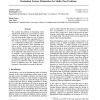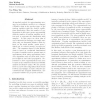95
Voted
ICML
2004
IEEE
15 years 6 months ago
2004
IEEE
Nested dichotomies are a standard statistical technique for tackling certain polytomous classification problems with logistic regression. They can be represented as binary trees ...
106
click to vote
ICML
2004
IEEE
15 years 6 months ago
2004
IEEE
The effort necessary to construct labeled sets of examples in a supervised learning scenario is often disregarded, though in many applications, it is a time-consuming and expensi...
91
Voted
ICML
2004
IEEE
15 years 6 months ago
2004
IEEE
We consider the problem of eliminating redundant Boolean features for a given data set, where a feature is redundant if it separates the classes less well than another feature or ...
107
click to vote
ICML
2004
IEEE
16 years 1 months ago
2004
IEEE
In kernel methods, an interesting recent development seeks to learn a good kernel from empirical data automatically. In this paper, by regarding the transductive learning of the k...
ICML
2004
IEEE
16 years 1 months ago
2004
IEEE
Surrogate maximization (or minimization) (SM) algorithms are a family of algorithms that can be regarded as a generalization of expectation-maximization (EM) algorithms. There are...
91
Voted
ICML
2004
IEEE
16 years 1 months ago
2004
IEEE
Classifier learning methods commonly assume that the training data consist of randomly drawn examples from the same distribution as the test examples about which the learned model...
ICML
2004
IEEE
16 years 1 months ago
2004
IEEE
108
click to vote
ICML
2004
IEEE
16 years 1 months ago
2004
IEEE
This paper addresses the problem of constructing good action selection policies for agents acting in partially observable environments, a class of problems generally known as Part...
ICML
2004
IEEE
16 years 1 months ago
2004
IEEE
A standard method for approximating averages in probabilistic models is to construct a Markov chain in the product space of the random variables with the desired equilibrium distr...
ICML
2004
IEEE
16 years 1 months ago
2004
IEEE
We introduce a framework, which we call Divide-by-2 (DB2), for extending support vector machines (SVM) to multi-class problems. DB2 offers an alternative to the standard one-again...



